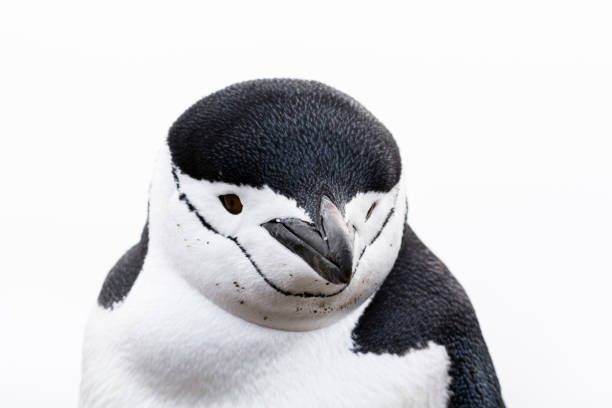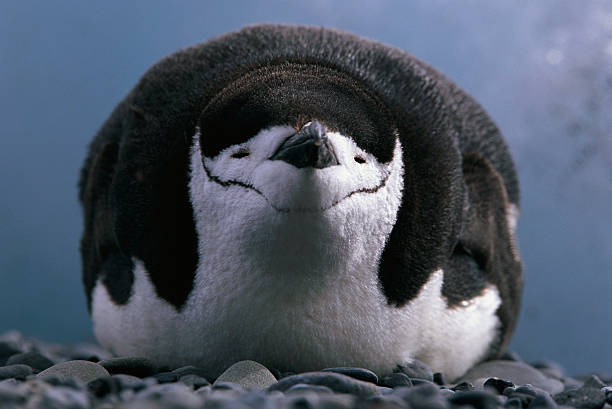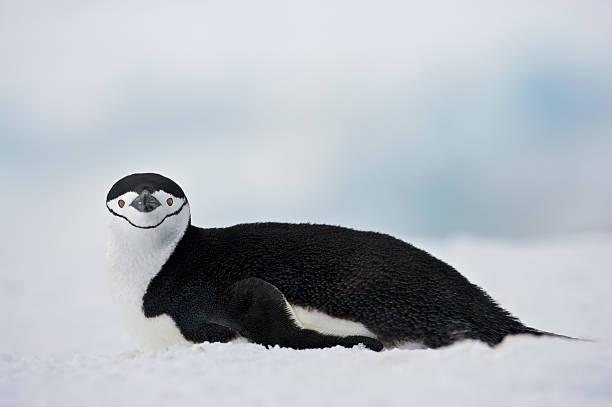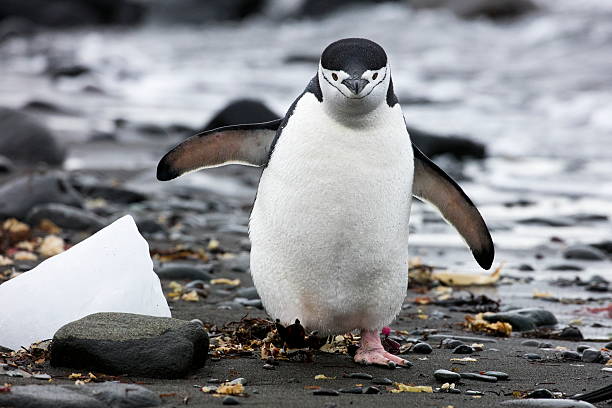Table of Contents
Scientific Classification
| Kingdom | Animalia |
| Phylum | Chordata |
| Class | Aves |
| Order | Sphenisciformes |
| Family | Spheniscidae |
| Genus | Pygoscelis |
| Species | Pygoscelis antarcticus |
| Scientific Name | Pygoscelis antarcticus |
Description
The Chinstrap Penguin gets its name from the distinctive thin black line that runs under its chin, resembling a helmet strap. It’s one of the most easily recognizable penguin species out there. These medium-sized birds typically stand about 68–76 cm (27–30 inches) tall and weigh in at around 3 to 5 kg (6.6 to 11 lbs).
Their plumage is a striking mix of black and white. The back, head, and flippers are a deep jet black, while their face and belly are a bright white. This color scheme helps them blend into the water. That bold black “chinstrap” really sets them apart from other species like the Adélie or Gentoo penguins.
While they might look a bit formal in their tuxedo-like appearance, these birds are anything but stiff. They’re lively, noisy, and bursting with personality!

Distribution
Chinstrap Penguins are true survivors, thriving in some of the most remote and rugged places on our planet. You can mainly spot them on the islands and coastlines of the Southern Ocean. Their biggest populations can be found in:
– The South Sandwich Islands
– South Shetland Islands
– South Orkney Islands
– Antarctic Peninsula
– Bouvet Island
– Balleny Islands
There are also smaller, scattered groups stretching from the South Atlantic to the sub-Antarctic islands. Interestingly, they tend to steer clear of mainland Antarctica, opting instead for ice-free coastal spots.
Habitat
Chinstrap Penguins are quite the characters, favoring rocky shores, steep cliffs, and coasts that are free of ice. Unlike some of their relatives, they shy away from the brutal interior of Antarctica. During breeding season, they return to land in massive colonies, sometimes numbering in the hundreds of thousands!
These penguins love spots that offer easy access to the open ocean for feeding, along with rocky slopes or plateaus for nesting. They thrive in chilly environments and often opt for land that’s windy and has minimal vegetation.
When they’re not busy breeding, Chinstrap Penguins spend their time at sea, either floating in the frigid southern waters or diving down to catch their meals.

Diet
Chinstrap Penguins are true carnivores, and their meals mainly consist of:
– Krill (especially Euphausia superba)
– Small fish (like lanternfish)
– Squid and other cephalopods
Krill is the star of their diet, making up the majority of what they eat. These penguins are fantastic swimmers, using their strong flippers to chase down their prey beneath the waves. They usually hunt at depths ranging from 30 to 100 meters, but they can dive even deeper if necessary.
When it comes to hunting, Chinstrap Penguins prefer to team up. They work together to herd schools of krill or fish, much like dolphins or wolves do.
Behavior
Chinstrap Penguins are quite the social butterflies, whether they’re splashing around in the ocean or hanging out on land. During breeding season, they gather in huge colonies and are always chattering away. Their calls serve important purposes, like helping mates recognize each other, communicating with their chicks, and defending their territory.
These little guys can be pretty feisty too! Males often get into tussles over nesting spots or potential partners, using wing slaps, pecks, and loud braying calls to assert their dominance.
While they might look a bit clumsy on land, they truly shine in the water. They have this cool way of “porpoising” at the surface or diving elegantly to snag their next meal. Their flippers work like wings underwater, allowing them to glide with powerful, controlled strokes.
On solid ground, they waddle in a charming way and even slide on their bellies to navigate over snow or ice with ease.

Lifespan
When it comes to lifespan, Chinstrap Penguins in the wild usually live between 15 to 20 years. Their chances of survival hinge on a variety of factors, such as predators, the environment, and how much food is available.
During their first year, chicks are particularly at risk. Mortality rates can soar to 50% due to exposure, starvation, or being hunted by predators. However, once they reach maturity, they face fewer dangers and enjoy a more stable lifespan.
Reproduction and Lifecycle
Breeding Season:
Chinstrap Penguins kick off their breeding season around October or November. Mated pairs come back together at their nesting spots, perfectly in sync with each other.
Nesting:
They create simple nests out of stones. The whole process of building and defending these nests can get pretty competitive—penguins often swipe stones from their neighbors! Males typically show up first to claim and prepare the nest, with females arriving a few days later.
Eggs and Incubation:
Females lay two eggs, and both parents take turns keeping them warm for several days. The incubation period lasts about 35 days.
Chicks:
When the chicks hatch, they’re covered in a soft, light gray down. Both parents feed them by regurgitating food. After about 3 to 4 weeks, the chicks gather into crèches (nursery groups) while their parents go out to forage. They fledge after 7 to 9 weeks and make their way to the sea.
Penguins reach maturity at around 4 to 7 years old, at which point they return to the breeding colony.

Predators
When it comes to adult Chinstrap Penguins, they don’t have to worry much about land predators, but the ocean is a different story. Here are their main threats:
Leopard seals – these sneaky hunters catch penguins off guard in the water or near the shore.
Orcas (killer whales) – these powerful creatures might hunt penguins when they’re out in the open sea.
Skuas and sheathbills – these birds are on the lookout for unattended eggs and chicks.
While humans aren’t direct predators, our activities definitely put penguin populations at risk. We disrupt their habitats, overfish their food sources, and play a part in climate change.
Adaptations
Chinstrap Penguins are great at living in some of the harshest places on Earth. Notable adaptations include:
Physical:
- Insulating feathers – dense, waterproof feathers provide insulation
- Blubber layer – a thick fat layer retains body heat
- Countershading – their dark back and white belly offer camouflage while swimming
Behavioral:
- Huddling – they gather in groups to conserve warmth
- Porpoising – efficient swimming behavior to escape predators and breathe while hunting
- Crèche formation – chicks form groups to stay safe and warm
Their vision is made for hunting underwater. Their strong claws also help them climb steep, icy surfaces.

Conservation Status
The International Union for Conservation of Nature (IUCN) has classified the Chinstrap Penguin as Least Concern. With more than 7 million breeding pairs scattered across the globe, this species seems to be doing pretty well overall.
That said, there are some worrying signs of population declines in certain areas. The main threats they face include:
Climate Change – rising temperatures are impacting krill populations and throwing ecosystems out of balance.
Overfishing – the struggle for food can lead to starvation among these penguins.
Pollution – oil spills and plastic waste are harming marine habitats.
Disturbance – the growing number of tourists and research stations can disrupt their breeding colonies.
To combat these issues, conservation efforts are focusing on a few key strategies. They’re keeping an eye on penguin colonies, protecting marine ecosystems, and managing human activities in Antarctica.
Final Thoughts
The Chinstrap Penguin might not have the same level of fame as its Emperor or Adélie relatives, but it’s just as captivating. This resilient bird thrives in one of the most extreme environments on our planet. From its bustling colonies to its graceful underwater foraging, it truly makes a mark.
We are the guardians of our planet. It’s our responsibility to ensure that species like the Chinstrap Penguin continue to flourish. Their world—cold, isolated, and breathtaking—is also ours to safeguard.



